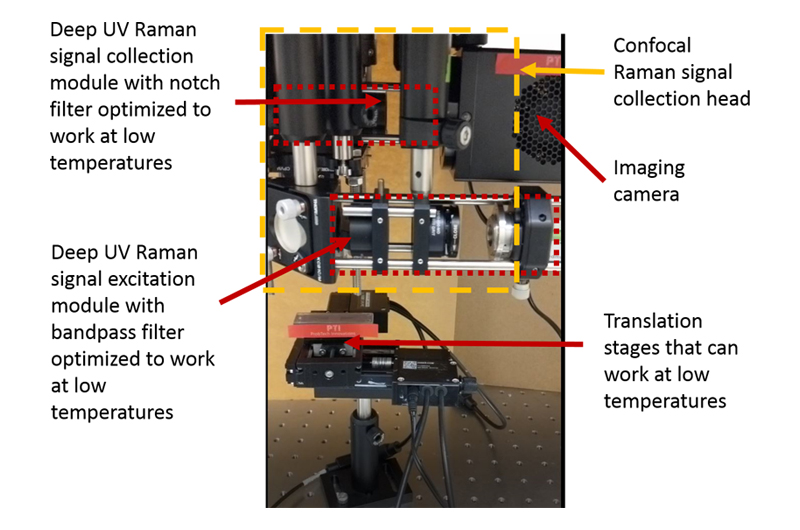CORaHE-ATTRACT project

The CORaHE project, funded by the ATTRACT-Phase 1 office (H2020, Grant Agreement 777222) was the successful first step of a previous research programme designed by a Basque Consortium integrated by:
-
IBeA Research, a group of excellence lead by Prof. Juan Manuel Madariaga (Department of Analytical Chemistry, University of the Basque Country (UPV/EHU)),
-
Probtech Innovation S.L. (PTI), a SME for instrument design and development lead by Dr. Gajendra P. Singh, located in Sopela (Bizkaia, Spain) and
-
IzotzaLab, a group lead by Dr. Sergio H. Faria within the Basque Centre for Climate Change (BC3, Scientific Campus of the UPV/EHU).
The common work of the Consortium before designing the CORaHE Project
In November 2017, IBeA and PTI started exchanging ideas and possibilities on a collaboration to develop Raman based sensors and spectrometers for dedicated applications in the research fields in which IBeA was engaged. The first shared project was the design and construction of the first version of a portable Deep-UV Raman spectrometer, working with an excitation laser at 248.6 nm, the same implemented in the SHERLOC instrument of the Perseverance rover (Mars 2020 mission, NASA), to detect organic molecules and hydrated minerals. This project was funded by the UPV/EHU (Grant No. INF18/24, July2018-July2019) after obtaining a remarkable evaluation (78/100) in the competitive call. The second shared project was the construction of a portable LIBS-Raman spectrometer, funded by the Retos-Colaboración Program of MINECO (Grant No. RTC2017-6306-5, Oct2018-Dec2021), a project that had another two partners from the University Complutense of Madrid (lead by Prof. Valentín García Baonza) and University of Valladolid (lead by Prof. Fernando Rull). Other ideas for the future were designed in 2019.
In June 2018, IBeA and IzotzaLab started also exchanging ideas on the possibility to apply Raman spectroscopy in the detection of inorganic and organic inclusions in ices, the field of research of IzotzaLab. It was natural to converge with PTI for future developments, and we started thinking on how to analyze icy samples by Raman spectroscopy inside the IzotzaLab.

Design of the CORaHE Project, Submission of the proposal and Funding for ATTRACT Phase 1
In July 2018 PTI, IzotzaLab and UPV/EHU agreed on a first approach to design a new Raman sensor, that was not available in the market in that time, to perform Raman measurements inside the cold laboratory that IzotzaLab was in the phase of final optimization.
At that moment, the ATTRACT call was published. We all agreed on the convenience to submit a proposal to that call because our designed new sensor was in one of the principal areas of development encourage by the ATTRACT office. You can download the proposed project submitted to ATTRACT at the end of October 2018.
After reviewing, our proposal was accepted and funded with 100.000 € for one year time period. The kick-off meeting was on the 19th and 20th of May 2020 in the CERN (Geneva) were we presented our project based on the slide you can download here.
Development of the Project
After the kick-off meeting, our consortium agreed in the detailed methodology, tasks and working plan that can be downloaded here. The CORaHE probe had to be compatible with the portable Deep-UV Raman spectrometer developed earlier by PTI and IBeA.
In the first six months of the project, PTI worked together with the team at UPV/EHU to finalize the procurement of optical and mechanical components required to build the CORaHE probe head. The materials were selected based on its design, carried out by PTI. Optical fiber length and core size were selected by considering deep UV transmission of > 90% power @ 248.6 nm. Similarly, the optical elements with the lower loss of energy were selected.
The design and construction of the excitation and collection modules was also performed with the aim to enable transmission of deep UV light between the cold and room temperature laboratories. The excitation and collection modules combined the optical fibres, optical filters, deep UV optics for light coupling and collimation and an enveloping jacket. These modules play a key role in delivering excitation energy from the laser (kept in the laboratory at room temperature) to the sample (kept in cold room) and in collecting scattered Raman light from the sample and carrying it to the deep UV detector placed in the laboratory that is kept at room temperature.
In the period December 2019 to February 2020, the components were assembled to build the CORaHE probe head and connected to the deep UV Raman spectroscopy system that is kept in the laboratory at room temperature. The video shows the first prototype of the CORaHE probe.
The design of CORaHE probe head is modular and flexible. The optical geometry can be adapted to the sample of choice. The fiber connectors allow repeated and near accurate coupling of deep UV light to the deep UV Raman spectroscopy system. This design allows performing measurements at room temperature and in the cold laboratory of IzotzaLab.
End of Phase 1 and Future Project Vision
The new CORaHE probe, developed under the ATTRACT Phase 1 project, can work between -40 and +80 oC, maintaining all of its features when measuring microscopic spots in frozen samples through the Deep-UV Raman spectrometer. Details are given in the research article that can be downloaded here.
The results obtained in the project demonstrate that our CORaHE head for microscopic Deep-UV Raman measurements has reached a Technology Readiness Level 4, that can be considered a great success.
Future developments are directed to scale and optimize the new CORaHE head during a forthcoming ATTRACT Phase 2 implementation. We have defined the steps required for scaling our Technology Readiness Level 4 (TRL 4), achieved in ATTRACT Phase 1, to TRL 7 in 30 months. Details of the design are given in the previously downloaded article.
